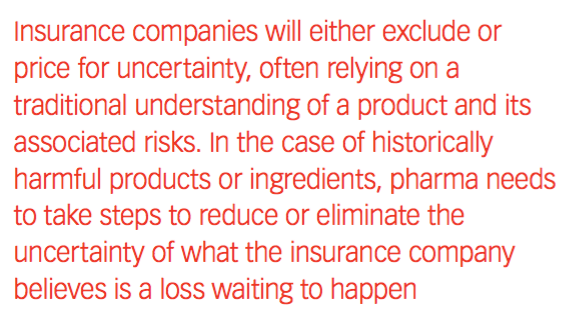Removing Uncertainty from the Drug Insurance Conversation
To gain better alignment of coverage and risk, evidence-based arguments are critical during the underwriting process.
In the 1950s, a drug called thalidomide came to market in West Germany. It was promoted as a sedative that alleviated insomnia, anxiety and tension, and was later used to combat morning sickness in pregnant women. But the drug had devastating side effects on newborns. Over the next several years, more than 10,000 infants were born with disfigured limbs, spinal cord defects and other disabilities, and many died shortly after birth. The drug, which was available in more than 46 countries under various brand names, was banned worldwide in 1961.
The pharmaceutical industry knows this story well. It was a hallmark case for the FDA, which resisted approving thalidomide in the US due to insufficient evidence of its safety. The department was hailed for its level of scrutiny, and a new era of stringent, but necessary, approvals was upon us.
But the story of thalidomide isn’t over. In the 1990s, researchers began evaluating thalidomide as a treatment for patients with cancer. It has since been approved by the FDA for treatment of multiple myeloma and skin complications caused by leprosy. Ongoing research continues to explore the drug’s effectiveness in treating inflammatory skin diseases and other cancers. Thalidomide is perhaps the best example of a comeback drug, once rejected by the global medical community but later re-introduced as an effective treatment.
Successfully bringing a product back to market or exploring new applications for drugs once considered harmful can be challenging and costly, with skepticism from regulators, physicians and patients at every stage of the process. And as pharmaceutical companies make their cases to various parties along the supply and approval chain, many fail to consider the important and often costly implications on their insurance policies.
The price of a comeback drug
There are many products and ingredients that insurers either commonly exclude from policies or price high-sometimes at a crippling rate. This primarily applies to drugs that are easily abused, or like in the case of thalidomide, have proven problematic in the past.
One timely example is the narcotic fentanyl, which is widely considered high risk for addiction and overdose. The growing issue of opioid addiction has motivated many pharmaceutical companies to explore alternative delivery systems for fentanyl, with the goal of finding an effective but non-addictive treatment approach. Yet most insurance policies include outright coverage exclusions for the use of fentanyl-or, if companies require coverage, insurers can charge them a fortune in product liability insurance.
This becomes a critical issue when pharmaceutical companies don’t factor increased insurance costs into the budget to bring a new product like this to market. By the time the price increases are accounted for, the new product’s pricing may be materially, and unexpectedly, different from the rest of their portfolio. Firms need

to ensure their due diligence process includes conversations with their insurance broker, to determine if and how they can secure coverage without compromising profitability of their product.
The most effective approach is to eliminate uncertainty from the underwriting process. Insurance companies will either exclude or price for uncertainty, often relying on a traditional understanding of a product and its associated risks. In the case of historically harmful products or ingredients, pharmaceutical companies need to take steps to reduce or eliminate the uncertainty of what the insurance company believes is a loss waiting to happen.
Building a compelling case
For insurance companies to accurately price the risk for a particular product or ingredient, they must fully understand how it is being used and delivered. It’s up to the pharmaceutical company to demonstrate this, and to curtail the concern for patient injury by qualifying the safety of the product.
This is done most effectively by gathering all key stakeholders during the underwriting process. Most often, a meeting is facilitated by the pharmaceutical organization’s insurance broker. The drug company’s scientists, risk managers, chief medical officer, head of regulatory and chief financial officer, among others, will come together with the insurance company to spell out exactly what will be insured, how it works, and how it’s different from what the insurers think they know about the medical product.
In this meeting, the pharmaceutical company’s scientists and researchers will walk through the chemical structure of the product and review clinical trial data, if available. The chief medical officer will field questions on its efficacy and safety. The risk manager will evaluate vulnerabilities and the evolution of this particular drug in the marketplace.
For drug companies with a deep bench of experts, this is the time to make evidence-based arguments to affirm the safety of the product and its feasibility in the market.
The insurance company’s underwriting team will then review the drug manufacturer’s evidence and potentially bring in a medical advisor or outside consultant to further evaluate it. If an update to the firm’s policy is warranted, underwriters will determine pricing and work with the broker to modify the policy accordingly. Most often, these changes will appear in a pharmaceutical company’s product liability policy under bodily injury and property damage. Importantly, these updates should also be made to the advertising injury and personal injury sections of a company’s general liability policy. Too often, pharmaceutical companies don’t realize that exclusions are mirrored across policies, and fail to ensure they have coverage in all of these areas.
The evidence or else
When adding a previously-or potentially-harmful drug or ingredient to their portfolio, pharmaceutical companies need to do everything in their power to prove the safety and efficacy to their insurers. By removing uncertainty from the conversation, companies can secure coverage and pricing that accurately match the risk of the product they’re bringing to market.

Daniel Brettler is Life Science Practice Leader at Conner Strong & Buckelew. He can be reached at dbrettler@connerstrong.com

Navigating Distrust: Pharma in the Age of Social Media
February 18th 2025Ian Baer, Founder and CEO of Sooth, discusses how the growing distrust in social media will impact industry marketing strategies and the relationships between pharmaceutical companies and the patients they aim to serve. He also explains dark social, how to combat misinformation, closing the trust gap, and more.
Pfizer, GSK Gain ACIP Recommendations for RSV and Meningococcal Vaccines
April 18th 2025The Centers for Disease Control and Prevention’s Advisory Committee on Immunization Practices voted to expand access to Pfizer’s respiratory syncytial virus vaccine Abrysvo for high-risk adults in their 50s and voted in favor of GSK’s meningococcal vaccine, Penmenvy, for streamlined adolescent protection.